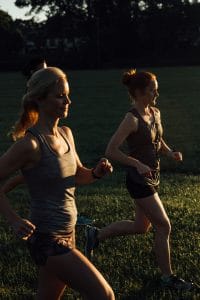Rebecca Weinand is a step-mother of two, a health and wellness coach, and an elite marathoner. I’m lucky enough to run a bulk of my miles alongside this amazing person. She lets me ramble, offers helpful perspectives, and never makes me feel bad if I’m running late. She’s thoughtful, profound, and, tough as nails.
A few years ago, when just 27, Rebecca began experiencing some strange things. Eventually, she was diagnosed with multiple sclerosis (MS). Remarkably, just one month after her diagnosis, she matched her fastest marathon time (2:57 on a very challenging and hilly course). This past fall, she clocked a new PR of 2:54.
Here’s her story in her own words.
Running with MS
“The original scans were wrong. You have a spot on your brain – either an inoperable brain tumor or an MS lesion. It may be best if you come in this afternoon.”

The scans were wrong. After that, I really stopped listening. I leaned back, the words stuck in my skull. Lesions. Tumor. MS. I couldn’t turn around – I just wanted to go for a run, to escape what I had just been told, to shake the words loose from my mind. I couldn’t turn around – I couldn’t face my two students who cared about me; I couldn’t say those words out loud; I couldn’t bear to see my fear reflected in their eyes. Yet, they knew. At only 17 or 18 years old, these two young men had nothing to offer as they saw the look on my face, avoiding eye contact at all costs. “You’re strong,” they eventually offered, but the fear remained.
They had seen my decline first hand – all my students had. A numb hand progressed to numb limbs; a numb hand morphed to handwriting that was illegible; illegible writing progressed to lessons that may have been unintelligible. The teacher they had thought of as robotic could no longer add 45 and 98 or explain the algorithms to graph a function on a calculator, yet they saw me as strong. The teacher they had thought of as the one who never stopped running now could barely keep up with them walking down the hallway, yet they saw me as strong. I may have been strong to them, but on the inside, my heart and my mind were breaking.
Related: How this mother runner cheated death while running a marathon
How could I teach if my mind became incapable of performing the basic operations that were fundamental to what I taught? How could I run if half of my body didn’t work? How could I form relationships if basic interactions required all the concentration and effort I could muster? How could I find true happiness if I could no longer move? How could I live my life when my mind and body were abandoning me? I had spent the past few months hiding from the reality that was so quickly destroyed in a 15-second phone call.
I had fooled myself into thinking that if I kept working, kept running, kept doing, it wouldn’t matter what was happening inside of me.
All the pretending, all the going, all the hiding, all the bravery ended in those 15 seconds. No matter what I did, I couldn’t stop what was happening inside my body. And the hiding ended.

A few minutes after receiving that call, I had texted friends and family and proceeded to walk into a meeting with about ten of my co-workers, only to be asked by a well-intentioned co-worker how I was feeling. Much to his dismay, this broke me. I lost it—right there in the library in front of my co-workers, in front of my assistant principal, in front of anyone who happened to walk by. As everyone sat dumbstruck, tears flowed down my face and I couldn’t keep hiding. I announced to whoever was in the room that they had found spots on my brain, cried, said I was fine and then sat down for the meeting.
If I couldn’t hide, I had to keep going.
I would keep my mind sharp so I could teach. I would master my body so I could run. I would maintain focus so I could interact at a meaningful level. I would keep moving so I could be happy. I would hold on to my mind and body so I could keep my life. I decided to keep going – to keep teaching, to keep running, to keep loving, to keep living.
Over the next few months, I had brain scans, multiple consults, a lumbar puncture, an IV steroid treatment and more bloodwork than anyone could ever need. Through it all, I ran. Running was no longer my way of hiding or controlling. I ran because, honestly, I didn’t know what else to do. Running had gotten me through what I thought was the worst of my life already and it was a piece of me. Running became the way I allowed myself to feel, the way I took time to process how my world was changing. Running was my way of keeping my mind and body connected – I couldn’t afford to lose either one and so I ran.
Related: How running helped this mother runner battle cancer
The official diagnosis came in February, but the speculation of an MS diagnosis came a few months earlier. The idea of a disease that could take my body or my mind on any given day was not something I thought I could handle. I wasn’t ready to face the reality that I had spent over a month in a classroom teaching lessons that may not have made any sense. I wasn’t ready to look at what it meant that I ran into stationary objects (like a concrete planter as tall as me!) while I was running because I couldn’t run in a straight line. I wasn’t ready to accept my training partner intentionally ran on my left side so I wouldn’t veer out into traffic and get hit by a car. I wasn’t ready to see that my vision was blurred for a month because of an unmanageable lesion on my brain. I wasn’t ready to accept that conversations lulled because I couldn’t keep up.
I wasn’t ready to live in a reality where every day may very well hold the worst surprise – loss of function.
I couldn’t hide anymore – that 15-second call ended that – and I wasn’t ready to accept it, so I decided to fight in any way I knew how.
I decided to fight by taking control. In retrospect, this may not have been the healthiest way to deal with a major diagnosis, but, at the time, it was either fight or freeze. As soon as the speculation of an MS diagnosis started, I took to heart a podcast my mom sent me and did a complete overhaul on my diet to follow the Wahl’s Paleo Protocol for MS – a strict regimen that has been shown to reverse the effects of multiple sclerosis. If I couldn’t control my body, I would control what I put into it. And once my symptoms were alleviated, I poured my heart and soul into running.
The specialists told me running long distances wasn’t such a great idea for this disease, but I wasn’t ready to give it up.
I had spent months fighting my body – dragging a leg while running, stopping by the river during a run crying because my body just wasn’t working, running while really just concentrating on staying in a straight line so I didn’t veer off into traffic, running with an IV port in my wrist – and I had spent years learning what it meant to live and be a runner. I wasn’t going to just let running go by the wayside.
Instead, I ran faster and longer, appreciating every step that came with feeling, every step that came unhindered, every moment my body would still move.
I had always used running as a way to hide or a way to control. My diagnosis helped me see what a privilege running was and I started seeing running as a way to simply feel and be free. The reality that I could wake up any given day and not be able to move made me deeply appreciate each step I did take. I stopped obsessing about miles and paces and just ran – enjoying the feeling of moving my body freely, noticing the sensations of running and enjoying the surroundings and connection I felt while I ran. Running became one of the most mindful, connected activities in which I participated – and it changed everything about how I ran.
When I ran, I was no longer hiding, I was no longer trying to control my body, I was simply alive and free. I ran with no real plan, no real goal, no real motive. The same was true when I toed the line of the 2015 Knoxville Marathon, just one month after my official MS diagnosis. I had no idea what to expect – I wasn’t even sure I could finish. However, the race will stick vividly in my mind as a race of freedom, a race of life-giving energy and a race of joy.

When I started the race, I just wanted to pace a friend and see how long I could keep up. The closer I got to the finish line, the more empowered I felt, the stronger I felt and the happier I was. Every mile after the infamous Noelton Hill, I just got faster. I wasn’t striving. I wasn’t fighting. I wasn’t hiding. I was moving towards freedom. I was embracing the unknown. I was letting myself see and be seen. The lyrics of a song went continually through my head “You’re almost home now; please don’t quit now; you’re almost home…
And so it was. As I finished that race, I knew I wouldn’t ever quit. I crossed the finish line with more joy than I ever thought possible at the end of a marathon – and it was because I was home. While I didn’t know what the future may hold, I knew I was home when I was doing what I loved. Running looks different now than it did on that day, but running is still part of home to me. Ever since that race, ever since my diagnosis, I no longer had to run to hide. I no longer run to control my surroundings. I no longer run to even fight the disease. Instead, I could run because I love it. I could run because it brings me joy. I run because I am free. I can run.
Rebecca is successfully managing her disease through medication, diet, stress management and, yes, running. She helps other people live healthier lives through her health and wellness coaching. Learn more about her work here.
Multiple sclerosis (MS) is an autoimmune disease that has no known cause or cure. MS causes a demyelination of the nerve pathways in the brain. There are multiple forms of MS with a variety of symptoms and outlooks. For more information, visit nationalmssociety.org.

I love this! Running has helped me cope with so many difficulties in life. It’s nice to see that common thread expressed in other ways.
Andrea, I agree! Running has so many powerful ways to impact our lives. It is definitely much more than just putting one foot in front of the other.